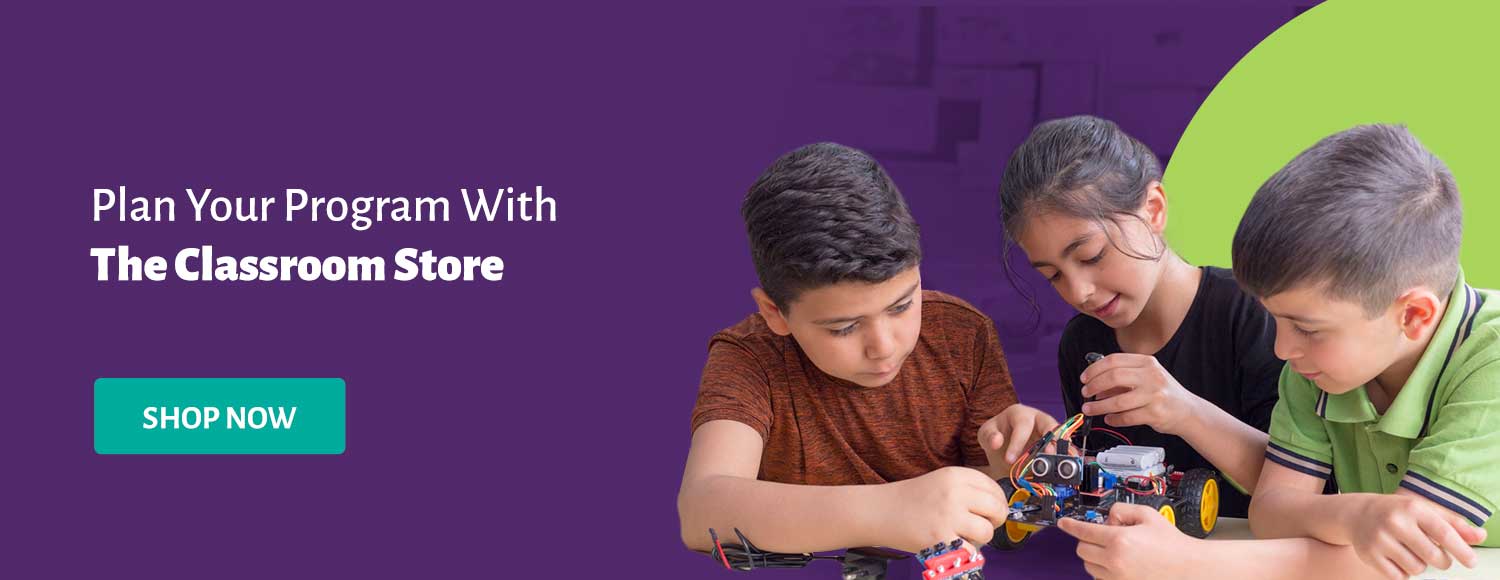Why Are After-School Programs Important?
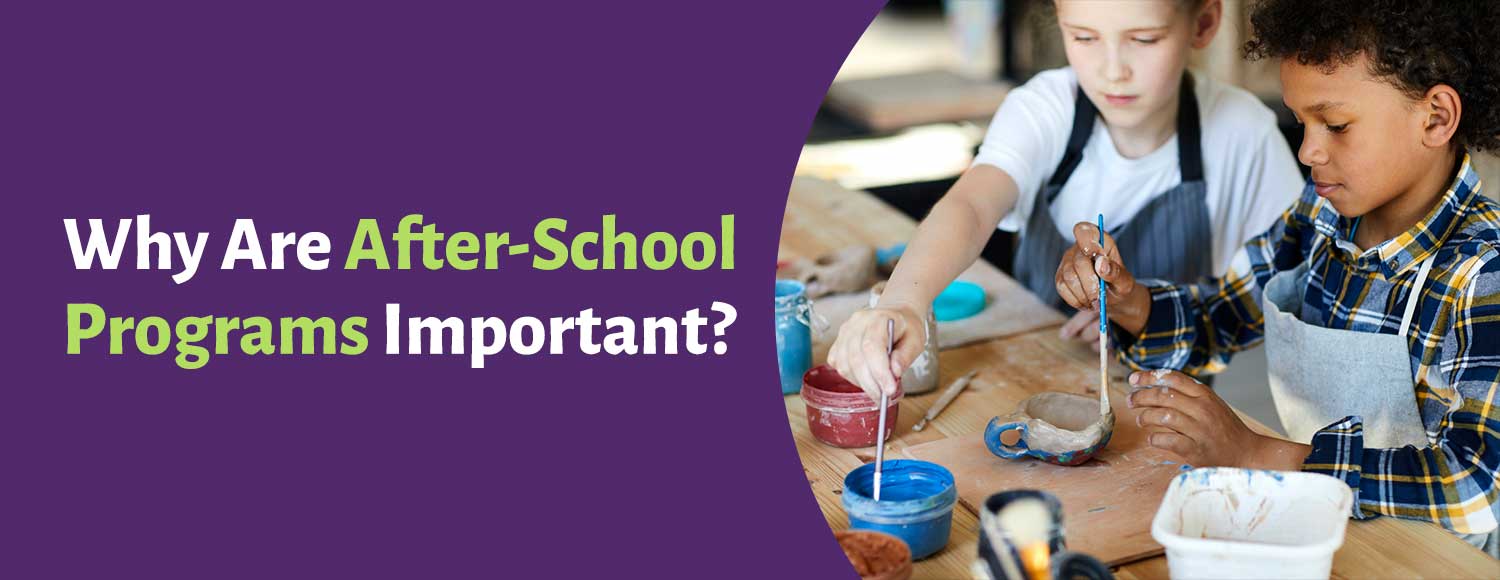
After-school programs take a developmental approach to improve school performance and behavior. These programs can affect children’s focus, concentration and other academic skills. They can help reduce the number of student tardies, increase assessment and test scores and lower dropout rates.
Overall, after-school activities are important because they give students the opportunity to explore their interests, bond with classmates, learn new skills and develop academic and social abilities. Kids can carry these experiences with them through the rest of their academic careers and into their life beyond school.
What Makes an After-School Program Successful?
Quality after-school programs will help improve a student’s academic abilities in one form or another, but they may do so using different approaches. These programs provide a safe environment for children to learn, make art, socialize or hone a skill before parents get home from work via engaging activities that pique their interests.
Determining a program’s success comes down to each goal and approach. The most effective programs will recognize the strengths of and give attention to each student. This holistic approach allows teachers and other advisors to promote more profound connections between students and their academics or interests. It also ensures every student’s well-being and social, physical, mental and emotional health.
A successful after-school program will do the following:
- Develop strong and positive relationships with adults
- Provide interesting challenges for students to overcome
- Allow students to tackle leadership positions and take initiatives
- Target student strengths and work to improve their weaknesses
- Give children an engaging environment to connect with peers
- Encourage students to find value in opportunities in the long run
- Focus on each child’s developmental needs and cultivate a positive self-image
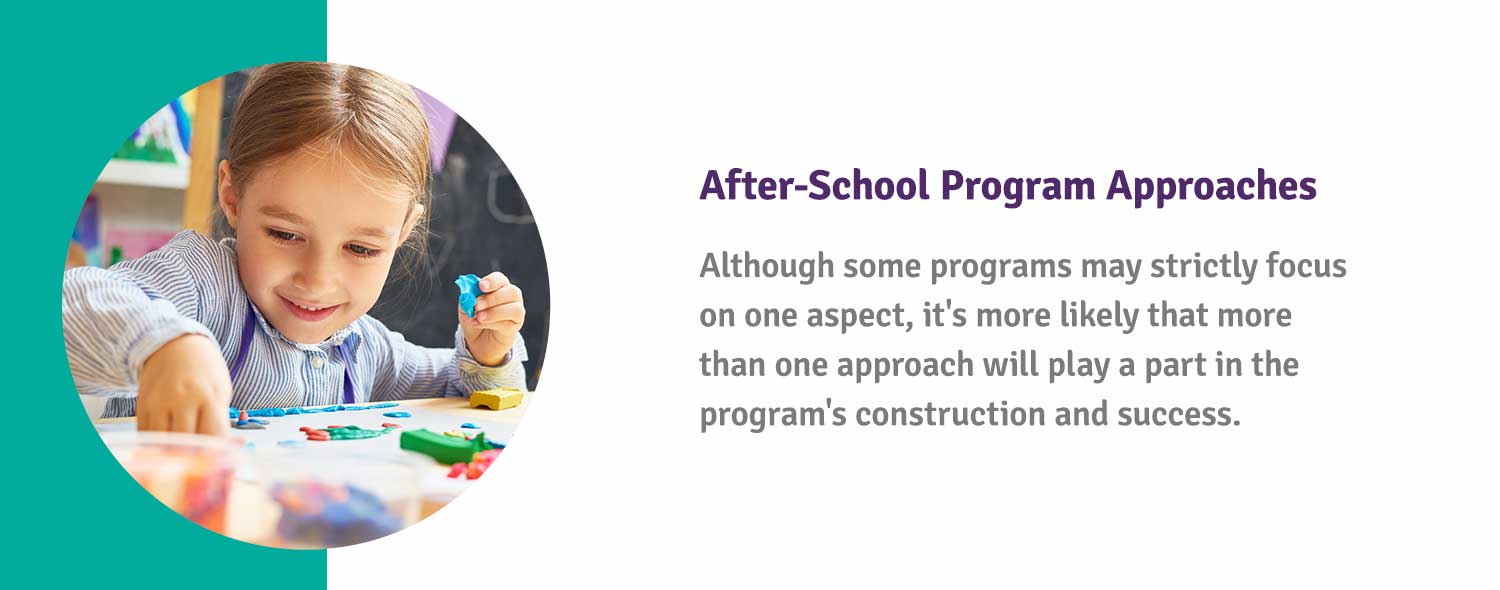
After-School Program Approaches
After-school programs may take one of three developmental approaches or a combination of multiple. Although some programs may strictly focus on one aspect, it’s more likely that more than one approach will play a part in the program’s construction and success.
Health and Wellness Programs
A program that promotes health and wellness will focus on improving a child’s relationship with food and activity. The activities children participate in combat child obesity and lead them to develop a healthy relationship with food and exercise.
Your school may offer various sports such as basketball, softball, cheerleading or football, but you can also look into YMCA activities and other groups that get children moving and teach them how to cater to their nutrition.
Social-Emotional Programs
Social-emotional programs emphasize social skills and give students leadership and initiative opportunities. These programs aim to boost self-confidence, improve communication, encourage relationships and give children a taste of self-sufficiency. Speech and debate, student government and programs that explore other cultures allow students to engage with others and learn how to interact with those who share different views.
Safe Environment Programs
These programs keep children away from the peak juvenile crime hours, which occur between the end of the school day and parents returning home from work. These programs provide a safe environment for children to learn about positive and negative actions and their correlated outcomes and suggest ways to avoid negative situations.
Programs such as career development, economics and art clubs can give children a focus on their futures and keep them from engaging in harmful behaviors. Additional health- and awareness-related programs may dive deeper into those subjects to educate children beyond their regular health classes.
Many programs overlap in their approaches. For example, an art club may boost a student’s self-esteem, promote wellness by giving stress-relief methods, keep children in a safe environment during peak crime hours and provide them with an alternative to negative actions. Although there may not be a significant focus on all three topics, these programs will still provide a positive environment for children to grow and thrive.
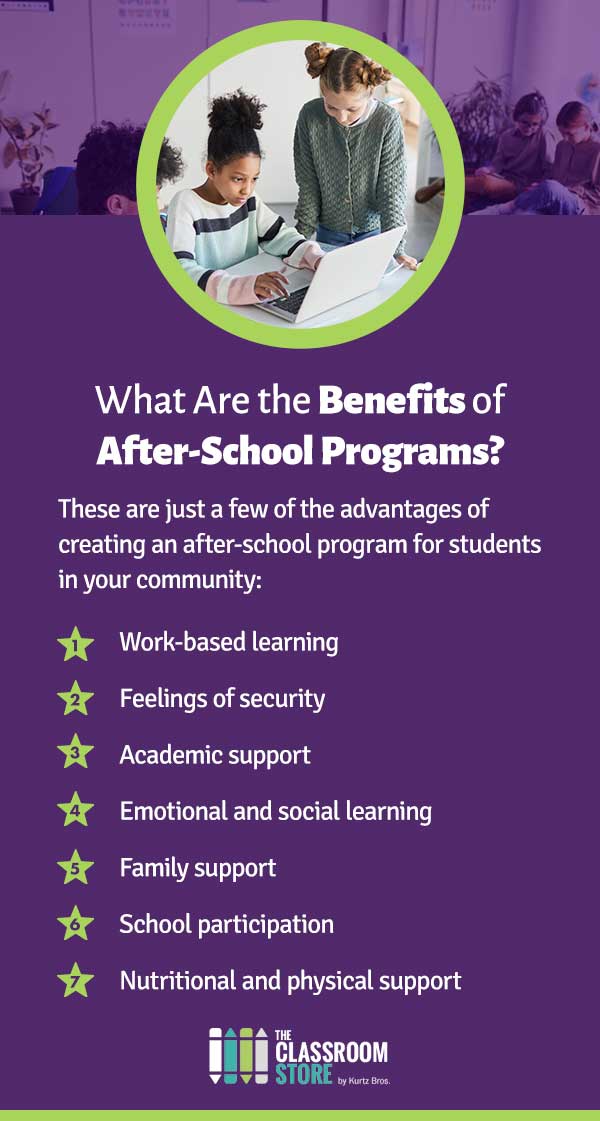
What Are the Benefits of After-School Programs?
After-school programs have a plethora of benefits that encourage students to develop healthy habits and discover new interests. These are just a few of the advantages of creating an after-school program for students in your community:
- Work-based learning: Children can learn and cultivate skills they can apply to their careers. Internships or job shadows give students opportunities to pursue their interests and understand the job market.
- Feelings of security: Adult supervision allows children to develop healthy relationships with adults and feel safe around them. Additionally, increased supervision will decrease children’s likelihood of participating in risky activities and encourage them to form connections with trusted individuals.
- Academic support: After-school activities improve academic success, provide students with additional opportunities to receive tutoring or coaching and expose high-achieving students to more rigorous material.
- Emotional and social learning: Children can develop healthy identities and navigate relationships with peers and extracurricular activities. Students may be exposed to peers they don’t typically see throughout the day or enhance an already well-formed relationship while improving their social and communicative skills.
- Family support: Parents and guardians can feel secure knowing their children are in a safe environment and participating in positive behaviors.
- School participation: After-school programs help reduce dropout rates, increase student retention and participation and close achievement gaps. These programs help make the transition from one school phase to the next much more effortless.
- Nutritional and physical support: To help children develop a better relationship with food and increase their daily physical movement, after-school programs can implement exercise and dietary discussions into their scheduled activities.
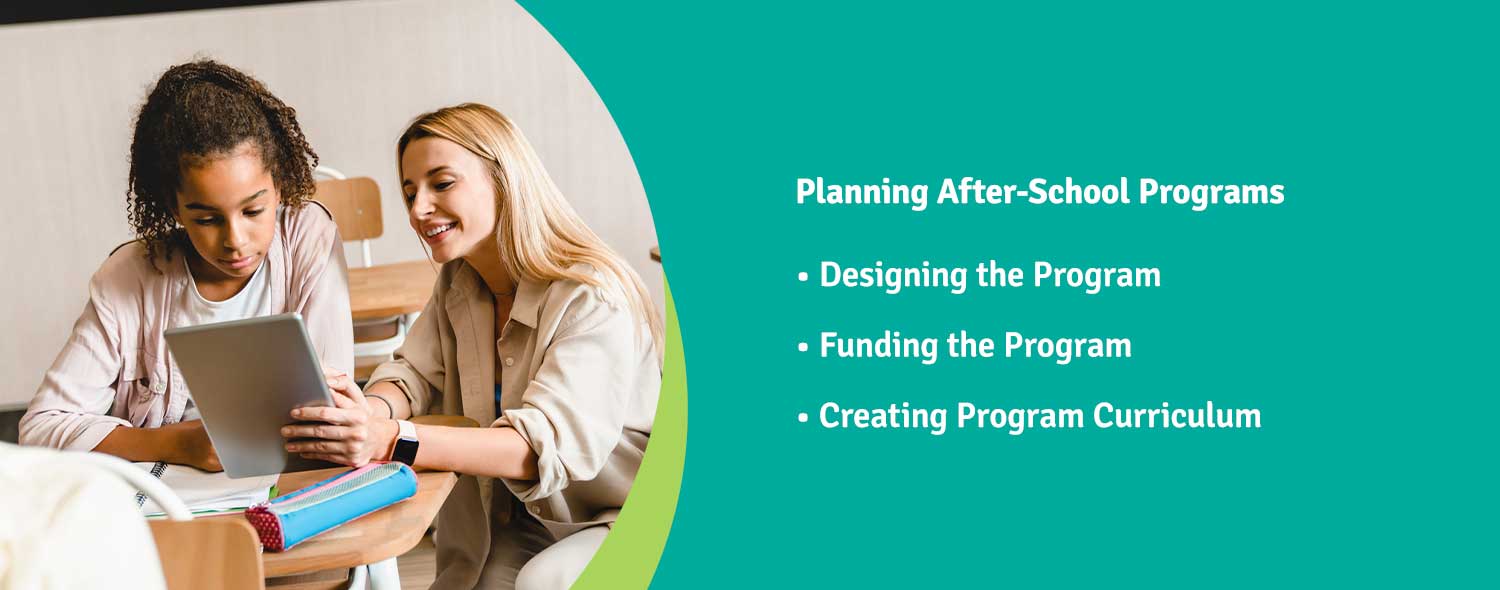
Planning After-School Programs
Before deciding on activities and tasks, you must first establish the program’s goals. Consider constructing a mission statement you can refer back to and structure your program and activities around. Determine what the children need, how they benefit from your program, what you can provide them and what you want the program to accomplish. Completing this process will help you identify gaps in students’ daily routines and implement the necessary changes.
Remember the logistics of your program. For instance, if your school needs additional funding, you must establish a budget. You’ll also need to ensure supervisors and space are available for your activities. Suppose you’re in a small school and every classroom or facility is in use after the school day ends. In that case, you’ll need to find another location to conduct your meetings and activities.
Additionally, your program may take place during the traditional semester, but you could seek to start a new summer program. Summer programs offer more flexibility and time for students to cultivate their skills. Many programs end when the final bell rings, but children need guidance year-round.
If your school has the means to house your program and your students are able to travel to meetings during the day, a unique summer program could be a fantastic way to encourage students to communicate and collaborate with their peers during the long break and continue to cultivate their skills.
1. Designing the Program
Beyond having a supervisor to hold meetings, you’ll need to establish if you need additional personnel to account for training, finances and day-to-day administrative functions. There may be many teachers in your school who aren’t currently involved with an after-school program, and they can be fantastic coaches and instructors. Parents and other community members may also be interested in volunteering to lead your group.
Additionally, you’ll want to establish a time for your students to meet that won’t conflict with existing programs. For instance, students in a show choir group may be interested in joining a dance team or band, learning about music theory or taking guitar lessons. Coordinating your program times and space with existing advisors is ideal so students don’t have to choose between one or the other.
Furthermore, be specific about your group’s age range. This may give you additional flexibility regarding when and where your group meets because students at this age can drive themselves or find friends to drive to meetings. Younger students may not have the means to travel, and you’ll need to ensure each participant has easy accessibility to the program.
2. Funding the Program
Receiving proper funding for an after-school program can make or break it. You should initially establish any startup costs you may encounter. If you’re going to rent a space or need to complete repairs, you should inquire about these first. Then, you’ll need to determine if you’ll need training manuals or other materials to prepare. You may need to purchase permits, licenses and additional professional fees and pay for insurance, maintenance fees or utility costs.
Even if you intend to meet on school property, you should still expect to see some additional costs. If you need to purchase equipment or supplies or offer an increased salary for staff, you must acquire the necessary funds before starting your program.
Additionally, you should establish travel expectations. If you plan to take field trips, need a bus to escort students to a facility or provide a secure way for students to travel home afterward, you’ll need to consider your travel options. Many schools offer an activity bus or other transportation to drop kids off at home in the evenings.
These buses typically leave the property at a scheduled time every night, but you may also be able to use them for additional travel directly after the school day. Either way, check with your administration to prepare for additional costs. In the event that your school doesn’t offer this option, reevaluate your travel plans or come up with an alternative solution.
There are external ways to fund your program. You could charge a one-time participation fee at the program’s start, organize fundraisers or set up a donation center for community members. Encouraging external involvement is a great way to involve your community in your program. These forms of funding may not supply enough funds to cover the entire program, but you can use them to get group shirts, take a fun field trip or reward your students with small gifts.
3. Creating Program Curriculum
A successful after-school program will have engaging activities you plan ahead of time. All of these activities should align with the mission statement and guide students toward whatever goals you’ve set. Additionally, you don’t want to run out of ideas or struggle to develop new ones as the program continues.
One of the challenges you may face is establishing activities that appeal to children of different ages. Your events will need to be adaptable for this reason. You may think an activity will be fun and challenging, but it actually proves to be easy for most of your students. In this case, you should have a supplemental activity that builds on or replaces the initial one. Be prepared to offer additional help and words of encouragement. Tasks that are challenging may result in children losing self-confidence or getting frustrated.
Thankfully, you don’t have to create all new ideas. You can modify well-known activities to even the playing field for all group members or invent tricks for your students to succeed. For example, you could conduct two basketball games on separate courts, one for younger kids and one for older kids. You should incorporate problems of varying difficulty for academic programs, allowing some questions to be simple and others to require additional work or research.
Remember that it’s always better to have a few backup ideas than to run out of them halfway through your program. You want to keep your students engaged so they get excited about attending meetings and participating in events. If you’re going to run your program for several years, you’ll need to plan new activities each year. Although some can be the same if your students thoroughly enjoy them or take valuable lessons away, returning students will want to see some variation.
Plan Your Program With The Classroom Store
The Classroom Store has been providing educational supplies since 1894. Our goal is to help educators ensure a fun, productive and safe learning environment that encourages children to thrive. We offer materials for all kinds of in-school and after-school programs — we have everything from paint supplies and chalk to early learning workbooks.
Whether you’re looking for teaching aids and instructional materials or need some new equipment for your after-school program, we’ve got you covered. Shop our classroom materials and find a planner for yourself, supplies for your students or additional resources to get your children excited about learning.


